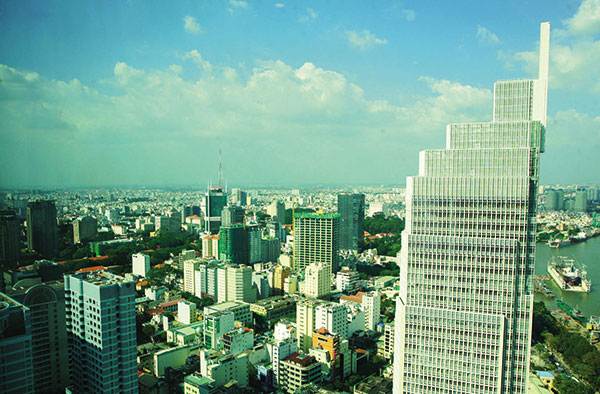Realty stays balanced at the top-end
 |
| Though the real estate market may seem unbalanced, experts say it is progressing well |
Economic expert Le Ba Chi Nhan said that the real estate market of Vietnam should be seen in a broader view, not limited to contrast in affordability.
“The real estate market of Vietnam, especially the high-end segment, still remains attractive for foreign and domestic developers,” Nhan said. “The recent opening for foreigners to buy houses in Vietnam is creating big demand in the high-end segment. As far as I know many projects have reached their 30 per cent limit for foreigners already.”
According to figures from the State Bank of Vietnam, more than 22 per cent of foreign remittance is invested in the real estate market, mostly in the high-end segment.
Marc Townsend, general manager of real estate firm CBRE Vietnam, said that the demand is increasing due to many units being made available under a buy-to-let format. In the east of Ho Chi Minh City for example, high-end units for leasing occupied more than 30 per cent of the total.
The municipal People’s Committee Deputy Chairman Le Van Khoa said that the causes of a potential real estate bubble are well controlled. “We expect the real estate market will progress in a normal manner, without any big changes or bubbling in 2017,” he said.
Ho Chi Minh City is setting up a database for the local real estate market, to offer official and trustworthy information to all investors, buyers, and brokers, whenever they need it. This data will also be a resource for policy makers and market controllers to draw on, to operate the market at its optimal.
By the most reliable measures, the real estate market looks healthy. It is supported by tangible drivers, such as the improvement of infrastructure systems in big cities and the increase in living standards of the population.
Recent research by Boston Consulting Group (BCG) said that Vietnam’s middle-class is growing faster than anywhere else in Southeast Asia. It said that Vietnam’s “middle and affluent classes” are expected to double in size by 2020, to 33 million people.
The business group considers people earning $714 or more a month members of Vietnam’s middle-class.
By 2020, BCG says, about one-third of the country will be defined as middle-class at least. This is a big opportunity for the real estate market in the years to come.
According to CBRE Vietnam, during this year’s first nine months, Hanoi’s residential market remains strong, with a good number of new launches.
A total of 5,279 units were recorded sold in this quarter, an increase of 52 per cent compared to last quarter.
The sales rate of the high-end segment has continued to rise since early 2016, with an average growth rate of 13 per cent.
In the year’s nine months, the number of apartments sold added up to approximately 14,200 units, of which nearly 50 per cent are mid-end apartments.
Meanwhile in Ho Chi Minh City, in the year’s nine months, the number of apartments sold reached 7,811 units, up 32 per cent compared to the previous quarter.
The overall mid-end segment continued to perform well, with more than 4,000 units sold in this quarter, accounting for over 50 per cent of total units sold countrywide. This strong result has been attributed to experienced developers with good sales and marketing strategies, as well as good distribution networks.
The net absorption reached 19 per cent in this quarter, representing an increase of three percentage points quarter-on-quarter, but a decrease of five percentage points compared to the same period in 2015.
What the stars mean:
★ Poor ★ ★ Promising ★★★ Good ★★★★ Very good ★★★★★ Exceptional
Latest News
More News
- JustCo expands business into Vietnam (December 22, 2025 | 17:58)
- Sun Group breaks ground on $2 billion Van Don casino complex (December 19, 2025 | 18:14)
- Rare, beautiful, sustainable: the mark of iconic real estate (December 19, 2025 | 08:00)
- Owner-occupied housing stabilises, paving the way for new growth cycle (December 18, 2025 | 17:04)
- Unlocking urban potential of smart cities (December 18, 2025 | 16:50)
- Green finance offers 'passport' for Vietnamese construction, building materials firms (December 15, 2025 | 08:00)
- Gamuda Land commit long-term investment (December 12, 2025 | 11:49)
- HITC ties up with Evolution to develop AI and hyperscale data centres in Vietnam (December 11, 2025 | 12:09)
- Real estate deals boom via high-profile names (December 08, 2025 | 11:32)
- Industrial segment shaped by M&As (December 08, 2025 | 08:00)

















 Mobile Version
Mobile Version